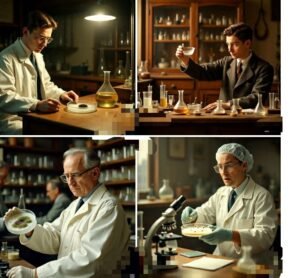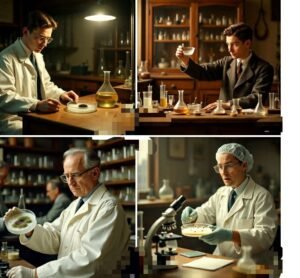📖 پینسلن کی مکمل کہانی: دریافت سے آج تک
پینسلن کو طب کی تاریخ میں سب سے انقلابی دوا کہا جاتا ہے۔ یہ پہلی اینٹی بایوٹک تھی جس نے انسانی زندگی کو بدل کر رکھ دیا۔ اس کی دریافت سے پہلے، عام انفیکشن بھی موت کا سبب بن جاتا تھا۔ مگر پینسلن نے نہ صرف انفیکشن کو قابو میں کیا بلکہ جدید طب کے نئے دور کا آغاز بھی کیا۔
Penicillin is often regarded as the most revolutionary drug in medical history. Before its discovery, even minor infections could be fatal. With Penicillin, not only were infections controlled, but a new era of modern medicine began.
🧬 1928 – دریافت (The Discovery by Alexander Fleming)
1928 میں اسکاٹ لینڈ کے سائنسدان الیگزینڈر فلیمنگ لندن کی St. Mary’s Hospital لیبارٹری میں کام کر رہے تھے۔ انہوں نے مشاہدہ کیا کہ ان کے پیٹری ڈش میں موجود Staphylococcus aureus بیکٹیریا کے اردگرد ایک فنگس (Penicillium notatum) اگ گئی تھی، اور جہاں یہ موجود تھی وہاں بیکٹیریا مر گئے تھے۔
In 1928, Scottish scientist Alexander Fleming, working at St. Mary’s Hospital in London, observed that a mold (Penicillium notatum) inhibited the growth of Staphylococcus aureus bacteria on a Petri dish. This chance observation became one of the greatest breakthroughs in medical history. 
🧪 1929–1938 – ابتدائی مشکلات (Early Struggles)
فلیمنگ نے اپنی تحقیق 1929 میں شائع کی لیکن اس وقت پینسلن کو دوا کی شکل میں تیار کرنا بہت مشکل تھا۔ فنگس بہت نازک تھی، اور اس میں موجود فعال جزو (active ingredient) کو الگ کرنا ناممکن لگ رہا تھا۔
Fleming published his findings in 1929, but isolating the active ingredient of Penicillin was extremely difficult. The mold was fragile, and the substance degraded quickly, making large-scale production impossible at that time.
⚙️ 1939 – آکسفورڈ ٹیم کی کامیابی (Oxford Team’s Breakthrough)
1939 میں آکسفورڈ یونیورسٹی کے سائنسدان ہاورڈ فلوڑی، ایرنسٹ چین اور نارمن ہیٹلی نے فلیمنگ کی تحقیق کو آگے بڑھایا۔ انہوں نے فنگس سے پینسلن نکالنے اور اسے جانوروں پر آزمانے کا کامیاب طریقہ ایجاد کیا۔
In 1939, Oxford University scientists Howard Florey, Ernst Chain, and Norman Heatley advanced Fleming’s work by purifying Penicillin and testing it successfully on mice. This was a turning point toward clinical use.
🏥 1941 – پہلا مریض (First Human Trial)
پینسلن کا پہلا کلینیکل ٹرائل 1941 میں کیا گیا۔ مریض البیرٹ الیگزینڈر شدید انفیکشن میں مبتلا تھا۔ پینسلن نے اس کی حالت بہتر کر دی، مگر دوا کی کمی کے باعث علاج مکمل نہ ہو سکا۔
In 1941, the first human trial was conducted on Albert Alexander, a policeman suffering from severe infection. His condition initially improved, but due to the shortage of Penicillin, the treatment could not be completed.
🌍 1942–1945 – جنگ عظیم دوم میں بڑے پیمانے پر استعمال (World War II Mass Production)
جنگ عظیم دوم کے دوران، امریکہ اور برطانیہ نے فوجیوں کو بچانے کے لیے پینسلن کی بڑے پیمانے پر پیداوار شروع کی۔ Pfizer نے صنعتی سطح پر Fermentation ٹیکنالوجی استعمال کر کے لاکھوں ڈوز تیار کیے۔
During World War II, the US and UK began mass production of Penicillin to save soldiers’ lives. Pfizer pioneered industrial fermentation, producing millions of doses, marking Penicillin as the “miracle drug.” 
💊 1950s – عوامی دستیابی (Public Availability)
1950 کی دہائی میں پینسلن عام مارکیٹ میں دستیاب ہوئی۔ یہ وہ وقت تھا جب اینٹی بایوٹکس کا نیا دور شروع ہوا۔ تپ دق، نمونیا، اسٹریپ تھروٹ، اور سیپسس جیسی بیماریاں اب علاج کے قابل بن گئیں۔
By the 1950s, Penicillin became widely available to the public, heralding the antibiotic era. Diseases like tuberculosis, pneumonia, strep throat, and sepsis were now treatable.
🔬 1960s–1980s – نئی اقسام اور ریسرچ (New Derivatives & Research)
سائنسدانوں نے پینسلن سے بنی نئی ادویات تیار کیں جیسے:
- Ampicillin (1961)
- Amoxicillin (1972)
- Carbenicillin, Oxacillin وغیرہ
یہ دوائیں زیادہ مؤثر تھیں اور مختلف انفیکشنز کے علاج میں استعمال ہوئیں۔
Scientists developed new Penicillin derivatives like Ampicillin (1961), Amoxicillin (1972), and Carbenicillin, Oxacillin, which proved more effective against a wider range of infections.
⚠️ 1990s – اینٹی بایوٹک ریزسٹنس کا آغاز (Rise of Antibiotic Resistance)
پینسلن کے زیادہ اور غلط استعمال نے بیکٹیریا میں مزاحمت پیدا کر دی۔ MRSA (Methicillin-resistant Staphylococcus aureus) جیسے خطرناک Superbugs سامنے آئے۔
The overuse and misuse of Penicillin led to bacterial resistance. Dangerous superbugs like MRSA (Methicillin-resistant Staphylococcus aureus) emerged, posing a serious global health threat.
🧑⚕️ فارماڈائنامکس (Pharmacodynamics – Mechanism of Action)
پینسلن بیکٹیریا کے سیل وال کی تیاری کو روکتا ہے۔ یہ β-lactam ring کے ذریعے transpeptidase enzyme کو بلاک کرتا ہے، جس کے بغیر بیکٹیریا اپنی دیوار مکمل نہیں بنا پاتے اور مر جاتے ہیں۔
Penicillin works by inhibiting bacterial cell wall synthesis. Its β-lactam ring blocks the transpeptidase enzyme, preventing bacteria from forming their protective cell walls, leading to cell death.
💉 فارماکوکائنیٹکس (Pharmacokinetics)
- Absorption: زیادہ تر پینسلن انجیکشن کے ذریعے دی جاتی ہے مگر Amoxicillin جیسی اقسام منہ سے بھی لی جا سکتی ہیں۔
- Distribution: جسم کے تقریباً تمام ٹشوز میں پھیل جاتی ہے۔
- Metabolism: زیادہ تر گردوں کے ذریعے خارج ہوتی ہے۔
- Half-Life: عام طور پر 30 منٹ سے 1 گھنٹہ۔
- Absorption: Mostly given via injection, though some forms like Amoxicillin can be taken orally.
- Distribution: Spreads to almost all body tissues.
- Metabolism: Mainly excreted through kidneys.
- Half-Life: Typically 30 minutes to 1 hour.
🌐 2000s عالمی ادارہ صحت کی ہدایات (WHO Guidelines)
اینٹی بایوٹک ریزسٹنس کو کم کرنے کے لیے WHO نے ہدایات جاری کیں کہ پینسلن صرف ڈاکٹر کی ہدایت پر استعمال ہو۔
WHO introduced strict guidelines for responsible antibiotic use, emphasizing that Penicillin should be prescribed only under medical supervision.
🔮 2010 مستقبل کی تحقیق Future Research
آج پینسلن اب بھی استعمال ہو رہی ہے لیکن بیکٹیریا کی مزاحمت بڑھ چکی ہے۔ سائنسدان نئی Synthetic Penicillins، CRISPR-based antibiotics اور بایو ٹیکنالوجی کے ذریعے حل تلاش کر رہے ہیں۔
Today, Penicillin is still in use, but resistance is rising. Scientists are exploring Synthetic Penicillins, CRISPR-based antibiotics, and biotechnology innovations to combat resistant bacteria.
پینسلن نے اربوں زندگیاں بچائیں اور طب کی دنیا کو بدل کر رکھ دیا۔ مگر اس کا زیادہ استعمال اب خطرہ بن رہا ہے۔ اگر ہم اینٹی بایوٹکس کو سمجھ داری سے استعمال کریں تو یہ دوا آنے والی صدیوں تک انسانیت کے لیے کارآمد رہ سکتی ہے۔
Penicillin saved billions of lives and revolutionized medicine. However, overuse threatens its future. Responsible use is essential to preserve its power for generations to come.


